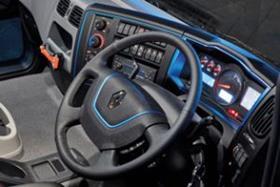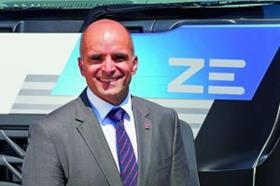
Renault Trucks is the first mainstream truck maker to come to market with a right-hand drive full-electric heavy truck in the shape of new Range D Wide ZE.
Renault has more than a decade’s experience with zero-emission trucks, and indeed supplied a hybrid electric 26-tonner to a major soft drinks company for deliveries during the 2012 Olympic Games. It launched the Master ZE van in late 2018, and following successful trials in the French city of Lyon, has now put the Range D ZE (16 and 26 tonnes) into series production.
The first example on these shores is this 26-tonner, which will soon be fitted with a refuse body. It has a normal Range D chassis, and a 3,900mm wheelbase. Tucked neatly between the chassis rails are four 50kWh batteries, which power twin electric motors (260kW continuous and 370kW peak). It is possible to specify six batteries on the 16-tonne chassis, giving 300kWh. Quick charging takes just two hours.
Renault is already seeing a lot of interest in the vehicle from potential buyers, and according to UK product manager Mike Stringer, one of the more commonly asked questions relates to the vehicle’s maximum range. He explains that there isn’t an obvious answer, pointing out that likewise it would be impossible to estimate the range of a diesel-powered Range D due to the many variables involved, such as the number of batteries specified, the application, driving style, terrain, and traffic and weather conditions. Instead, he reassures potential customers that Renault will work closely with them, ensuring that they specify a ZE that’s suited to their exact operational requirements.
Uniquely, Renault is offering a 10-year battery performance promise with all trucks supplied on maintenance contracts, giving buyers additional peace of mind. It guarantees that after 10 years a 200kWh battery pack will either still have 125kWh of useable energy per full charge, or will have delivered 250MWh of total energy during its lifetime (whichever comes first). Likewise, a 300kWh battery will have 187.5kWh of energy left, or will have delivered 375MWh.
Because the ZE uses Renault’s familiar Range D Wide cab it doesn’t resemble most people’s preconceived idea of what a zero-emission truck should look like. While this is probably a good thing for the majority of drivers, there will no doubt be some operators who will be disappointed. Some early adopters of zero-emission trucks will add one to their 500-strong fleet of diesel-powered trucks so they can shout about their green credentials.

Inside the cab the normality continues. Anyone used to driving a regular Range D will find this interior very familiar. Other than a subtle splash or blue here and there, the dashboard is largely unchanged. What you get are a handful of easy-to-decipher dials, providing only need-to-know information.
Directly ahead of the driver is a power meter, which is split into blue, white and red sections. White depicts regular driving, blue signifies regeneration. If you spend prolonged periods in the red, the vehicle’s range will be seriously compromised. The fuel gauge shows the state of battery charge, while an eco-mode dial monitors long-term driving style.
The only other notable difference between this and the diesel-powered Range D, is that the gear selection stalk has been replaced by D, P and R buttons on the dashboard.
Turning on the ignition illuminates the dials, but other than a gentle hum from the electric motor, that’s the only clue that you’re ready to drive. Then it’s a case of covering the brake, selecting D, and away you go.
The D Wide ZE is incredibly easy to drive. It really is just a case of pointing and shooting. That said, Renault will be providing specific driver training with every ZE sold. As far as we can tell, the only remotely challenging aspect to piloting this truck is getting used to the retardation. There are three ways to regenerate the battery on the move; by easing off the accelerator, by activating the brake pedal, and by using the five-stage retarder.
The truck is unnervingly quiet to drive, with wind circulating around the mirrors being one of the more dominant sounds. In fact it’s so silent that you can even hear the suspension moving.
The ride in this particular truck with no body weight is, as you would expect, a bit on the choppy side. The plus side to running this light is performance. Electric trucks are renowned for their rapid acceleration, a consequence of maximum torque from standstill, and this chassis-cab is particularly quick off the mark, with traction control frequently having to step-in to prevent the wheels from spinning.
While it may be sexy or exciting, the Range D Wide ZE is here now. You can go into your local Renault Trucks dealer and place an order for one, and you’ll be driving it away later this year.
We have used the word normal a lot, and for good reason. Give it a few short years and zero-emission trucks like this will be commonly used for urban distribution. The Renault Range ZE, and the trucks that follow it, will be the new normal.
The cost of being green

The ZE is dearer than its diesel-powered sibling, but by how much is a mystery. Despite asking a few people, we failed to get an answer. What we did get however, was the following statement from Renault Trucks UK MD Carlos Rodrigues, pictured: “Capital prices are obviously higher for electric vehicles, but the reduction in operational costs is significant, and the gap in the total cost of ownership narrows significantly and could approach parity once we compare diesel versus electric on higher mileages or highly demanding fuel operations such as refuse collection. Also, we should have in mind that investments made by customers today are protected against tax changes for the next 10 years.
“Having already attained the gold standard of zero emissions, when operators invest in an EV today, they can be sure that they will comply with the most stringent CAZ, LEZ or congestion charges which are ahead of us for the foreseeable future. With this stated, you then understand that in the coming years with scale, more technology development and more support to the industry on EVs, the total cost of ownership on the urban environment and last-mile delivery sector is a no brainer.”












